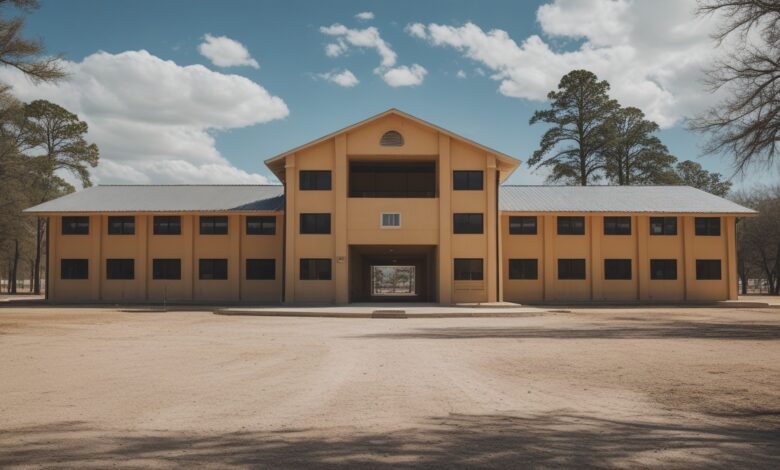DOGE HHS Migrant Housing Contract: A Story of Change and Care for Kids

Introduction
Imagine a big house built to keep kids safe and warm. But what if that house sits empty, with no kids inside, while grown-ups keep paying a lot of money for it? That’s what happened with the DOGE HHS Migrant Housing Contract. This is a real story from the United States government. It shows how leaders tried to fix a problem and make things better for children who travel far to find a new home.
In simple words, the DOGE HHS Migrant Housing Contract was an agreement to build and run places where kids from other countries could stay safe. These kids are called migrants. They come to the U.S. without parents, looking for help. But the plan didn’t work as hoped. In March 2025, a new group called DOGE stepped in and stopped the contract. They said it was wasting money – about $18 million each month! By ending it, they saved $215 million a year. This change sparked big talks about how to care for kids the right way.
This article explains everything step by step. We’ll use easy words so kids age 6 and up can understand. We’ll talk about what DOGE and HHS are, why the contract started, what went wrong, and what we can learn. Let’s dive in like an adventure story!
What is the Department of Government Efficiency (DOGE)?
DOGE sounds like a fun dog’s name, right? But it’s short for Department of Government Efficiency. Think of it as a team of smart helpers who look at how the government spends money. Their job? Find ways to use less money and do more good things.
DOGE started in early 2025, right after a new president took office. Famous people like Elon Musk and Vivek Ramaswamy helped lead it. Elon makes cool cars and rockets, and Vivek talks a lot about making rules fair. They wanted the government to run like a speedy race car – fast, smart, and without extra junk.
One of DOGE’s first big jobs was checking old agreements, like the DOGE HHS Migrant Housing Contract. They asked: “Is this helping kids? Or just burning money?” Their answer led to big changes. DOGE isn’t about being mean. It’s about being smart with everyone’s money – your family’s taxes too!
- Fun Fact: DOGE’s name comes from a funny internet dog picture called “Doge.” But this DOGE is all business!
The Role of HHS in Caring for Migrant Children
Now, meet HHS. That’s the U.S. Department of Health and Human Services. HHS is like a giant family doctor for the whole country. They help with health, food, and safety for kids and grown-ups.
A special part of HHS is the Office of Refugee Resettlement (ORR). ORR cares for kids who come to America alone. These are migrant children from places far away, like Mexico or far-off countries. They cross the border hoping for a better life – maybe to escape danger or find family.
When these kids arrive, ORR finds them a safe spot to stay. It could be a cozy house, a school-like building, or a big shelter. The goal? Give them food, doctors, teachers, and hugs until they can live with a family in the U.S. It’s like a bridge to a new home.
During busy times, like 2021 when many kids came, ORR needed more rooms fast. That’s when they made deals like the DOGE HHS Migrant Housing Contract. But caring for kids costs money, and ORR wants to do it right.
The Story of the DOGE HHS Migrant Housing Contract
Every good story has a beginning. Let’s go back to 2021. That’s when the DOGE HHS Migrant Housing Contract began. It was like signing a promise: “We’ll build a super shelter for kids!”
How It Started
Lots of migrant kids were coming to the U.S. border. ORR needed emergency help. They picked a group called Family Endeavors, a nonprofit from San Antonio, Texas. Nonprofits are like helpful clubs that do good without making big profits.
Family Endeavors got the job to run the Pecos Children’s Center. Pecos is a town in West Texas, with wide deserts and sunny skies. The center was built big – it could hold up to 2,000 kids! There were classrooms for learning, rooms for doctors, playgrounds for fun, and spaces to talk with helpers about their feelings.
The deal? Pay $18 million every month. In return, keep the place ready for kids anytime. It was a “just in case” plan. ORR said, “Build it now, use it when needed.” No big contest for who got the job – it was a quick choice to help fast.
This was part of a bigger wave. From 2021 to 2024, ORR spent billions on shelters. The DOGE HHS Migrant Housing Contract was one piece of that puzzle.
The Big Problem
Fast forward to 2024. The border got quieter. Fewer kids needed spots right away. By March 2024, the Pecos center was empty – no kids, no noise, just echoes. But the money kept flowing: $18 million a month for an empty house!
Imagine paying for a huge birthday party, but no one shows up. For a whole year, that’s what happened. Taxpayers – that’s you and me – paid over $200 million for nothing. DOGE heard about this in early 2025. They said, “Whoa! This can’t go on.”
Why DOGE Ended the Contract
In March 2025, DOGE made a big call. They told HHS: “Stop the DOGE HHS Migrant Housing Contract now!” The Pecos center closed for good. Why? Simple reasons:
- It was empty. Zero kids since March 2024. Paying for ghosts isn’t smart.
- Too much money wasted. $18 million monthly adds up fast. Ending it saved $215 million a year.
- Better ways to help. DOGE wanted money for real needs, like smaller homes closer to families.
Elon Musk shared the news on his X account (that’s like Twitter). He said it was a win against waste. But not everyone cheered. Family Endeavors said, “Hey, we did nothing wrong! We were ready to help.” They called the bad talk “baseless,” meaning not true.
DOGE’s move was like cleaning a messy room. It felt good, but some toys got tossed out too soon.
What Changed After the End?
After March 2025, things got busy. HHS looked at all their deals. They promised:
- More checks. Weekly reports on how money is spent.
- New rules. No more paying for empty spots. Facilities must show real use.
- Better care. Shorter stays for kids (from 27 days to 18 days) and more family reunions (89% success).
The saved money? It went to other helps, like health checks or school supplies for migrant kids. Some went to build smaller, cozier shelters near cities.
But there were bumps. In April 2025, news came out that DOGE looked at private kid info – like health records. That worried people. “Is it safe?” they asked. HHS fixed it by adding guards, like locks on a diary.
Overall, the end of the DOGE HHS Migrant Housing Contract made the system smarter. It’s like upgrading from a giant bike to a speedy scooter – easier to handle.
Debates and Different Views
Not everyone agrees on the DOGE HHS Migrant Housing Contract story. It’s like a playground argument: Some say “Yay!” Others say “Boo!”
- Supporters of DOGE: “Great job saving money! Now we can help more kids with less waste.” They like how it cuts “disaster capitalism” – making bucks off sad times.
- Helpers for migrants: “Don’t cut too fast! Kids need beds now.” Groups worry it hurts quick aid during busy border days.
- Family Endeavors: “We followed rules. Blaming us is unfair.” They point to past good work, like housing thousands in 2021-2023.
Experts say: Balance is key. Save money, but never skip kid hugs or safe beds. The debate teaches us to listen to all sides.
Here’s a quick list of pros and cons:
| What Happened | Good Side | Tricky Side |
|---|---|---|
| Contract Ended in March 2025 | Saved $215M/year for real help | Lost a “just in case” big shelter |
| More Oversight | Weekly checks stop waste | Takes time from caring for kids |
| Faster Family Reunions | Kids home quicker (89% rate) | Some say care felt too “cold” |
This table shows it’s not black and white – like choosing ice cream flavors!
Lessons Learned from the DOGE HHS Migrant Housing Contract
Stories like this teach big lessons. First, check your plans often. What works today might not tomorrow. Second, money matters, but kindness more. The DOGE HHS Migrant Housing Contract reminds us: Help kids with heart and smarts.
For grown-ups: Governments should bid deals openly – no secrets. For kids: If you see waste, like extra toys not used, speak up! It makes the world fairer.
In 2025, new rules came: Audits every few months and team-ups with local groups. This could make future contracts better.
FAQ: Quick Answers About the DOGE HHS Migrant Housing Contract
Q: What is the DOGE HHS Migrant Housing Contract? A: It was a deal from 2021 where the government paid $18 million a month to run a big shelter for migrant kids in Texas. It ended in March 2025 because it was empty.
Q: Why did DOGE stop it? A: The shelter had no kids since March 2024, but money kept going. DOGE wanted to save $215 million a year for better uses.
Q: Are migrant kids okay now? A: Yes! HHS made changes like shorter stays and more family matches. Over 89% of kids found homes faster.
Q: Was it fair to end the contract? A: Some say yes – it cut waste. Others say no – it might slow emergency help. Both sides have good points.
Q: Can kids like me help migrant children? A: Sure! Draw pictures, share toys with new friends, or tell grown-ups to be kind. Small acts make big smiles!
Conclusion
The DOGE HHS Migrant Housing Contract is more than numbers and news. It’s a tale of kids far from home, brave leaders fixing mistakes, and a country learning to do better. From the empty halls of Pecos to saved millions in 2025, it shows change can be good – if done with care.
We learned that wasting money hurts everyone, especially little ones needing beds and books. But we also saw hope: Faster homes, stricter checks, and talks about fairness. The U.S. is big and busy, but stories like this make it kinder.
Remember, every migrant child has a dream, just like you. Let’s build bridges, not walls – with money well-spent and hearts wide open.
Stay in touch to get more updates & alerts on Magbuz! Thank you




